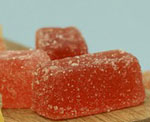Types of Vinegar
"So many different types of vinegar
conveniently reviewed on one page!"
Apple Cider vinegar as well as many other types of vinegar are widely used for their culinary and medicinal benefits.
When made with care, most vinegars contain a host of healthful antioxidant compounds and nutrients derived from the fruit, grain, or sugar from which they are produced.
Each vinegar type has its own taste characteristics which go well with certain kinds of food found in various regions.
Herbs, spices and fruits can be infused in the milder types of vinegar to produce herbal or flavored vinegars with greatly enhanced tastes which you can tailor make or purchase for your cooking needs.
Apple Cider Vinegar (liquid)
An apple cider vinegar (ACV), which is unfiltered and not pasteurized and made from whole organically grown apples, is the best type to use for
both health and cooking purposes.
This type of ACV which usually has a 5% acid level, can be found in most local health food stores and even in some general grocery stores.
I use a certified organic apple cider vinegar (which contains the “mother”) made by Bragg and one made by Omega Nutrition. Both are delicious and I can highly recommend them.
The Bragg and Omega Nutrition 32 ounce (946mL) bottles of organic apple cider vinegar are shown below and can be purchased online from Amazon.com.
(To purchase from Amazon, click on the picture below. I will earn a small commission, at no cost to you.)
Many other commercial apple cider vinegars have been pasteurized, filtered, refined or distilled in order to make the product look good, and thereby more appealing to the general public. Unfortunately this extra processing destroys much of the healthy goodness and thus many of the apple cider vinegar benefits that were in the product in the first place.
Once opened, an apple cider vinegar with at least 5% acidity does not need to be refrigerated and has a minimum shelf life of 5 years. Best to store the vinegar with the cap tightly closed and not in direct sunlight.
Apple cider vinegar goes well on vegetable salads, seafood and poultry and is an excellent base for making infused vinegars with various herbs, spices or fruits.
Some people find it more convenient to take apple cider vinegar in tablet, pill, or capsule form rather than in the traditional liquid form but you have to be careful about choosing which supplement to use.
The ACV supplement has to contain an equivalent amount of acetic acid and converting liquid vinegar into powder form requires much extra processing which could reduce some of the nutrients present in the original apple cider vinegar liquid.
To this end, 8 apple cider vinegar tablet products were analyzed in 2005 by a team of scientists from the Department of Human Environmental Science (Human Nutrition) at the University of Arkansas and they found many labeling inconsistencies and inaccuracies which made them question the quality of these ACV tablets.
Reference:
J Am Diet Assoc. 2005 Jul;105(7):1141-4. (
Web Link
)
An April 2018 study reported on the effect of commercial vinegar pills as well as liquid Apple Cider vinegar for managing insulin resistance. After 8 weeks, they found that insulin resistance was reduced 12% in the liquid apple cider vinegar group as compared to no reduction in the ACV pill group.
Reference:
"A comparison of liquid vinegar and commercial vinegar pills for managing insulin resistance and postprandial glucose concentrations." Carol S. Johnston, and Natasha Feise
Published Online: The FASEB Journal, 20 Apr 2018, Abstract Number: 925.10 ( Web Link )
More recently however, in 2022, Bragg has come up with an ACV supplement in capsule form and they state that "Just three pills a day has the same amount of acetic acid as one tablespoon of apple cider vinegar”.
So if you are looking for the convenience of an apple cider vinegar capsule, then this is the one I would recommend:
(To buy it, click on the Amazon picture or link below. I will earn a small commission, at no cost to you.)
This is one of the newest ways of adding apple cider vinegar to a popular product.
Convenience and taste are the driving factors here, after all, who doesn't like the taste and portability of gummy candies?
The leading manufacturers of ACV gummies, though, are also adding other ingredients such as pomegranate, beetroot, curcumin, and blackcurrant to the gelatine or starch matrix. So the resulting apple cider vinegar product tastes more like a fruit snack.
Another nice feature is that the leading manufacturers are stipulating the exact amount of apple cider vinegar in their product which is usually 500 mg of 5% apple cider vinegar per one or two gummies.
Unfortunately this is nowhere near the amount of apple cider vinegar recommended to obtain health benefits such as weight loss or blood glucose level reduction.
At 500 mg of 5% ACV per one or two gummies, you would have to take at least 30 gummies a day to get the recommended daily dose of 5% apple cider vinegar. (One tablespoon of 5% liquid vinegar.) This fact is backed up by third-party lab testing as mentioned in a May 03, 2022 Bragg survey news release.
If you can't stomach the taste of traditional liquid ACV even when mixed with other liquids or if you are away from home often and its not convenient to bring a bottle of apple cider vinegar with you, then you could consider trying a reputable supplement such as Bragg ACV supplement. Three of these capsules would be needed to get the daily dose equivalent to one tablespoon of liquid ACV.
Balsamic Vinegar
True balsamic vinegar, labeled aceto balsamico traditizionale, has been produced for a thousand years in the Emilia-Romagna region of northern Italy. This includes an area starting from the Adriatic Sea and reaching almost to the Gulf of Genoa. This type of vinegar is made from the reduced juice of sweet white grapes such as the Trebbiano and Lambrusco varieties and is aged for 12 or more years in a progression of aromatic wooden casks.
Sweet and sour, smooth and mellow, and dark purple brown in color, balsamic vinegar is full of subtle complex flavors. It is used as an ingredient in salad dressings, sauces and marinades and even as a toping sprinkled on fresh strawberries or ice cream.
A much more readily available quick-processed industrialized version of balsamic vinegar is produced in Modena but even this, by Italian law, has to be aged for at least 3 years to be labeled aceto balsamico. It usually has a 6% acid content.
Click here for more information
about the history, production and types of balsamic vinegar and how it is used in several Italian recipes.
Cane Vinegar
These types of vinegar are made from fermented sugar cane extract and are used mostly in Philippine cooking.
Coconut Vinegar
Coconut vinegar is made from the sap of the coconut tree that is naturally fermented in about two months and then aged for about 8 months.
Coconut vinegar is often made with a low 4% acetic acid content and has a mild, yet unique, musty flavor and distinct aftertaste. This type of vinegar is widely used with Thai, Philippine, Indian and other Southeast Asian cooking.
Like apple cider vinegar, coconut vinegar can also be purchased in a raw, unpasteurized, and unfiltered form for maximum nutrition and health benefits.
Malt Vinegar
The English have been using malt vinegar for hundreds of years. It's especially popular sprinkled on chips in a traditional fish and chips restaurant.
Malt vinegar is made from grain, especially barley whose starch has been converted by malt to an alcoholic liquid that is subsequently fermented to a 5% malt vinegar. It has a strong hearty taste.
Red Wine Vinegar
Red wine vinegar, like apple cider vinegar, has been used for centuries for both medicinal and culinary purposes.
These types of vinegar can vary in color from light rose to deep red and acid content from 5 to 7%. They are used worldwide, especially in Mediterranean countries, in sauces, salads, marinades for red meat, and as a pickling agent for fruits and vegetables.
Rice Types of Vinegar
Rice vinegar has been made in China and Japan for thousand of years. It is made from rice wine, or sake and comes in three varieties, white, red and black.
On the southern Japanese island of Kyushu, the black variety is produced from thick sake made only from brown rice using a lengthy natural outdoor process. This vinegar has a mild sweet flavor and is highly regarded for it's medicinal properties.
Generally, these types of vinegar have a 4 to 5% acid content and are used in salad dressings, and as a condiment for soups, stews and noodle dishes. This type of vinegar is also added to sushi rice, not only for adding flavor but also for killing dangerous bacteria that could be present on raw fish.
It's mild flavor makes it excellent for flavoring with herbs, spices and fruit.
Sherry Vinegar
Made from sherry wine in Andalusia, southwestern Spain, sherry vinegar is smooth and mellow with a slight toasted almonds flavor and a balanced sweet and sour taste. These types of vinegar are aged in oak casks and often produced by the Solera system over a lengthy period of time. The Duque de Diano label of aged sherry vinegar made in Jerez de la Frontera is one of the best examples.
These types of vinegar normally contain 7 to 8% acetic acid content and are widely used in Spanish cooking, especially with sweet poultry dishes, salads and sauces.
Click here for information
on the Solera aging process, a number of leading sherry vinegar manufactures and several traditional Spanish recipes.
White Wine Vinegar
White wine vinegars can vary in color from white to pale gold and acid content from 5 to 7%. These types of vinegar are light flavored and like apple cider vinegar they go well on vegetable salads, seafood and poultry and they are a good base for making infused vinegars with various herbs, spices or fruits.
White Vinegar (White Distilled Types of Vinegar)
Large amounts of white distilled vinegar are made annually and widely used in the food industry for pickling and as an ingredient in many condiments such as ketchup and mayonnaise.
Sold at a 5% acidity level, this vinegar is harsh and coarse-flavoured with little nutrient value. White distilled vinegar cost less than other types of vinegar, can be readily found in most grocery stores and is well suited for house cleaning and weed killing chores.






